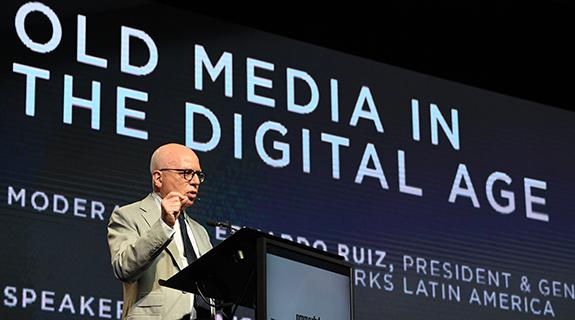“What are you watching?”
Those four words form a question that sits at the center of a changing television culture that journalist, entrepreneur and bestselling author Michael Wolff and moderator Eddy Ruiz, president and general manager of A&E Networks Latin America discussed during the session “Old Media in the Digital Age” at PromaxBDA: The Conference 2016.
A Volume Seller of Low-Cost Ads
Twenty years ago, people were willing to believe that digital was killing television, even though there were no success models. Twenty years later there are only two success models: Google and Facebook, Wolff said. And they are the singular business of being volume sellers of low cost ads.
“Content had to become cheaper and traffic had to become greater,” Wolff said.
It led to an influx of of user generated articles, listicles, and other low-quality content that was produced in high quantity. Meanwhile, television improved as more people began paying for content. Somewhere along the line, digital started to understand the competitive advantage of premium content, he said.
“Until suddenly what you had, basically, fundamentally, was television,” Wolff said. “The internet went into the television business.”
The only thing on Netflix is television, he said. It’s some new form of digital media, but the same medium on a different platform.
“What they don’t say, what they can’t say, is television has been a big disappointment,” he said. “But if you read between the lines, that’s what they are saying.”
Netflix, Hulu and other streaming services may be featuring original content, but they’re not producing it themselves.
“The television industry is producing it,” he said. “They have to go to the traditional source of television content, and pay big money, that puts them in position to expand the base of the television industry.”
Before we had broadcast and cable; now we have broadcast, cable and streaming.
“The value of the media is in the art of storytelling,” Wolff said. “The better the story, the better the media, the more money we make from it.”
Making Sense of the Metrics
“Traffic is not an audience,” Wolff said.
Digital sites may brag about having huge audiences, but the metrics are skewed, Wolff said.
“Any reasonable person at some level has to look at these numbers and say what’s going on here? How can that possibly be? We’ve exceeded the number of people in the world.”
He used Buzzfeed’s 200 million visitors as an example.
“Twice the size of the Super Bowl audience, and yet they basically make what a mid-sized magazine makes,” he said. “Everything is out of whack here in terms of the comparison of apples to apples.”
The move toward dynamic ad insertion is a good one, he said, and the industry needs to create a future that puts measurement of both digital and television on the same page.
[Photo courtesy of Image Group LA]
Tags:













































__twocolumncontent.jpg)











